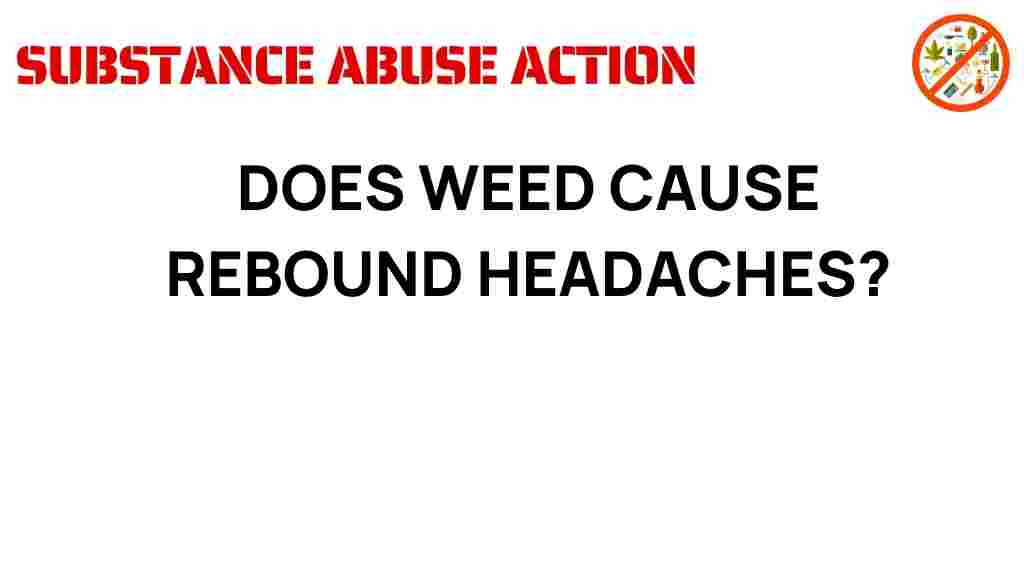The Hidden Truth: Does Weed Really Cause Rebound Headaches?
Cannabis has gained significant attention in recent years, especially for its potential to alleviate chronic pain and provide headache relief. However, there is an ongoing debate about whether the use of cannabis, particularly THC and CBD, could lead to rebound headaches. In this article, we will explore the relationship between cannabis effects and rebound headaches, and examine the implications for those suffering from chronic pain and migraine treatment.
Understanding Rebound Headaches
Rebound headaches, also known as medication overuse headaches, occur when pain relief medications are used too frequently. They can lead to a cycle of increasing headache frequency and intensity, often making the original pain condition worse. Here are some key points to understand:
- Definition: Rebound headaches are secondary headaches that result from the overuse of acute headache treatments.
- Causes: These headaches can be triggered by various medications, including over-the-counter pain relievers and prescription drugs.
- Symptoms: Symptoms typically include a dull, persistent headache that occurs daily or almost daily.
- Duration: They can last for hours or even days, often improving temporarily after taking medication.
How Cannabis is Used for Pain Relief
Cannabis, particularly in the form of medical marijuana, has been explored as a treatment option for various types of chronic pain. The active compounds in cannabis, THC (tetrahydrocannabinol) and CBD (cannabidiol), interact with the body’s endocannabinoid system to help alleviate pain and reduce inflammation.
The Dual Nature of Cannabis Effects
While many individuals report positive experiences with cannabis for chronic pain and migraine treatment, there are potential downsides to consider:
- Short-Term Relief: Cannabis can provide significant short-term headache relief for some users.
- Potential for Dependency: Regular use of cannabis can lead to psychological dependency, which may complicate pain management.
- Risk of Rebound Headaches: Some individuals may find that frequent use of cannabis leads to rebound headaches, mirroring the effects seen with traditional pain medications.
Examining the Evidence: Does Cannabis Cause Rebound Headaches?
The question of whether cannabis causes rebound headaches remains controversial. Research is limited, but several studies suggest that the risk may be present for some individuals:
Current Research Findings
1. **Limited Studies**: There are few comprehensive studies specifically examining the relationship between cannabis use and rebound headaches. Most research has focused on traditional medications.
2. **Patient Reports**: Anecdotal evidence from patients indicates that while some find relief from cannabis, others report an increase in headache frequency when using it regularly.
3. **Type of Cannabis**: The type of cannabis used, including the ratio of THC to CBD, may influence the likelihood of developing rebound headaches. Higher THC levels may be more likely to cause dependency and subsequent headaches.
Step-by-Step Process for Using Cannabis Safely
For those considering cannabis for chronic pain or migraine treatment, it’s essential to approach its use cautiously. Here’s a step-by-step guide:
Step 1: Consultation with a Healthcare Provider
Before starting cannabis, consult with a healthcare provider familiar with medical marijuana. They can help you understand potential risks and benefits based on your health history.
Step 2: Start with Low Doses
Begin with low doses of cannabis, focusing on strains with a balanced THC and CBD content. This can help minimize the risk of dependency and rebound headaches.
Step 3: Monitor Usage
Keep a journal to track your cannabis use, headache frequency, and severity. This can help identify patterns and determine if cannabis is beneficial or if it may be contributing to rebound headaches.
Step 4: Establish a Routine
Establish a consistent routine for cannabis use. Avoid using it daily if possible. Instead, use it on an as-needed basis to prevent potential overuse.
Step 5: Explore Other Treatment Options
Consider integrating other headache management strategies alongside cannabis, such as:
- Over-the-counter pain relievers (in moderation)
- Physical therapy and exercise
- Stress management techniques, such as meditation or yoga
Troubleshooting Tips for Cannabis-Induced Headaches
If you find that your cannabis use is leading to rebound headaches, consider the following troubleshooting tips:
Assess Your Consumption
Evaluate how frequently you are using cannabis. If you find that you are relying on it daily for relief, it may be time to take a break.
Switch Strains
Experiment with different strains of cannabis. Some may work better for you than others, particularly those with higher CBD content and lower THC levels.
Incorporate Breaks
Implement regular breaks from cannabis use to reduce the risk of dependency and rebound headaches. This could be a few days off every week.
Stay Hydrated
Dehydration can exacerbate headaches. Ensure you are drinking enough water throughout the day.
Consult a Specialist
If headaches persist, consider consulting a headache specialist who can provide tailored advice and treatment options.
Conclusion: Weighing the Risks and Benefits
In conclusion, while cannabis has shown promise in providing relief from chronic pain and headaches, it is essential to remain vigilant about the potential for rebound headaches. The effects of THC and CBD can vary significantly from person to person, and understanding your own body’s response is crucial.
For individuals struggling with chronic pain, headache relief through cannabis may be a viable option, but caution is warranted. Always consult with a healthcare professional, monitor your usage, and consider other treatment options to ensure a comprehensive approach to headache management.
For more information on managing chronic pain and exploring treatment options, visit this resource. Additionally, for scientific studies related to cannabis and headaches, check out this research article.
This article is in the category Health and created by SubstanceAbuseAction Team
